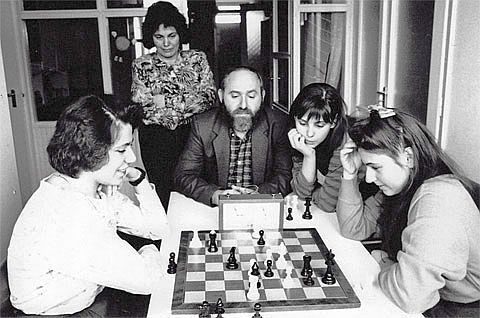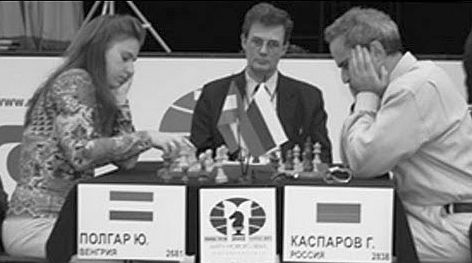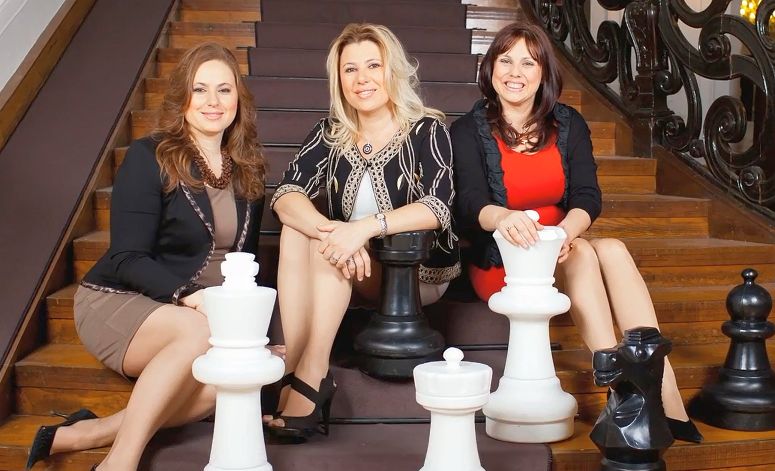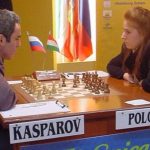In mijn overzicht van vrouwelijke wereldkampioenen elders op deze site, mist u wellicht Judit Polgar: de sterkste vrouwelijke schaker ooit. En waarom is dat? Ze weigert gewoon om een vrouwelijke wereldkampioen te worden en speelt alleen in mannen toernooien! Ik maak dit goed met een korte bio:
Judit Polgar (geboren 23 juli 1976) is een Hongaarse schaakster. Zondermeer de beste vrouwelijke schaker in de geschiedenis. In de FIDE-ELOlijst van april 2004 (inclusief mannen en vrouwen) stond ze op nummer negen van de wereld met een ELO van 2728.
Polgar-zussen
Judit en haar twee oudere zussen (Zsuzsa (GM) en Zsofia (IM)) (van links naar rechts op de foto hieronder) maakten naar verluidt deel uit van een educatief experiment dat door hun vader werd uitgevoerd, Dat was zijn poging te bewijzen dat vrouwen, net als mannen, hoge mentale niveaus konden bereiken wanneer ze getraind worden vanaf zeer jonge leeftijd (zie hieronder meer).
Judit, Zsuzsa en Zsofia Polgar
Hij wilde zijn dochters op veel gebieden onderwijzen, niet alleen schaken, maar alle drie begonnen ze op jonge leeftijd met het spel en bereikten al snel een niveau dat maar weinig mannen ooit bereikten.

Jongste GM
Judit had vrijwel zeker meerdere keren de titel van wereldkampioen schaken voor vrouwen kunnen winnen. Geen enkele andere vrouw stond zelfs maar in de top 100 van de FIDE-ratinglijst van januari 2004. Ze heeft echter geweigerd deel te nemen aan schaakevenementen voor alleen vrouwen en verklaarde dat ze de echte wereldkampioen schaken wil worden. Een van haar prestaties is het behalen van de grootmeester-titel voor heren op de toenmalige recordleeftijd van 15 jaar en 4 maanden, een maand eerder dan het vorige record van Bobby Fischer.
Haar opmars in de gelederen leek haar ooit op de route naar het wereldkampioenschap te brengen, maar hoewel ze veel partijen won van enkele van ’s werelds beste spelers, was het winnen van een toernooi nog niet gelukt. Ze is er ook niet in geslaagd voormalig kampioen Garry Kasparov te verslaan in een van hun ontmoetingen met de klassieke “lange” tijdcontrole. In 2002 versloeg ze uiteindelijk Kasparov in een rapid partij in de “Rusland versus de rest van de wereld 2002” ontmoeting.
In 2015 stopte ze met competitief professioneel schaken.
Het Polgar-experiment
Onderwijspsycholoog László Polgár bestudeerde de biografieën van 400 genieën. Van Socrates tot Einstein, hij onderzocht ze allemaal. En nu bereidde hij zich voor op een van de meest extreme experimenten ooit gedaan – zo extreem dat mensen dachten dat hij gek werd. Een lokale overheid zei hem zelfs dat hij naar een psychiater moest gaan om ‘hem van zijn wanen te genezen‘.
Maar Polgár was vastbesloten. Hij had alleen een vrouw nodig die bereid was aan boord te komen.
Laszlo en Klara
Met een aantal jongedames begon hij te corresponderen over het pedagogische project dat hij voor ogen had. Klára, een lerares vreemde talen, was een van hen. “Zoals velen in die tijd dacht ik dat hij gek was“, herinnert Klára zich, “maar we spraken af om elkaar te ontmoeten.” Toen ze aan het daten waren, raakte Klára gecharmeerd van hem en raakte geïnteresseerd in zijn gedurfde idee.
Ze trouwden uiteindelijk. En zo begon het experiment.
Ze noemden hun eerste dochter Zsuzsa. En al snel volgden Zsofia en Judit. László en Klára zegden hun baan op en wijdden hun leven aan het thuisonderwijs van hun 3 kinderen. Polgár geloofde dat talent niet bestond. Iedereen kan een meester worden op elk gebied – de top 3 procent – als je de juiste oefening toepast. “Een genie wordt niet geboren, maar wordt opgeleid en getraind“, vertelt Polgár aan The Washington Post. “Als een kind gezond wordt geboren, is het een potentieel genie.”
Polgár was altijd een voorstander geweest van de praktijktheorie in tegenstelling tot de talenttheorie. Hij schreef papers over het onderwerp en lobbyde bij de regering om het onderwijssysteem te veranderen. Maar niemand wilde luisteren. “Kinderen hebben een buitengewoon potentieel en het is aan de samenleving om het te ontsluiten“, zegt Polgár. “Het probleem is dat mensen het om de een of andere reden niet willen geloven. Ze lijken te denken dat excellentie alleen toegankelijk is voor anderen, niet voor zichzelf.”
Bewijs
Omdat niemand wilde luisteren naar wat hij te zeggen had, was de enige manier om het te bewijzen.
Hij zou zijn kinderen opvoeden tot genieën. Het kostte hem veel tijd om een veld te kiezen om zich op te concentreren. Nadat zijn eerste dochter was geboren, wist hij dat het tijd was om eindelijk een beslissing te nemen. “Ik wilde dat de prestaties van Susan zo dramatisch waren dat niemand hun authenticiteit in twijfel kon trekken“, zegt hij. “Dat was de enige manier om mensen ervan te overtuigen dat hun ideeën over excellentie helemaal verkeerd waren. En toen drong het tot me door: schaken.”
Hij besloot te gaan schaken omdat de meting objectief was. “Als mijn kind was opgeleid als kunstenaar of romanschrijver, hadden mensen kunnen discussiëren over de vraag of ze echt van wereldklasse was of niet. Maar schaken heeft een objectieve beoordeling op basis van prestaties, dus er is geen argument mogelijk.” Met andere woorden, als hij van tevoren aankondigde dat zijn kinderen schaakgenieën zouden worden en het voor elkaar zou krijgen, was zijn theorie over meesterschap bewezen.
Schaken
Polgár, zelf amateurschaker, dook de diepte in en leerde zoveel mogelijk over schaaktraining. Met de hulp van zijn vrouw toverde hij hun bescheiden appartement in het hart van Boedapest om tot een heuse schaaktempel. Het had een bibliotheek met duizenden schaakboeken op planken aan de ene muur, en aan een andere muur hingen schaakdiagrammen. Een dossierkaartsysteem nam een hele derde muur in beslag. Het bevatte records van eerdere partijen en zelfs een index van de toernooigeschiedenis van potentiële concurrenten.
Toen hij zich eenmaal voldoende ontwikkeld voelde als trainer, begon hij schaken bij elk van zijn dochters te introduceren. En terwijl de kinderen ook alle reguliere vakken leerden en meerdere talen spraken, stond schaken altijd centraal.

Eerste resultaten van Susan (Zsuzsa)
Op 4-jarige leeftijd won Susan, de oudste van de Polgár-zussen, haar eerste schaaktoernooi, het Budapest Girls Under-11 Championship, met 10-0. Op 12-jarige leeftijd won ze het Wereldkampioenschap voor meisjes onder de 16 jaar. Op 15-jarige leeftijd werd ze, ondanks beperkingen op haar vrijheid om in internationale toernooien te spelen, de best beoordeelde vrouwelijke schaker ter wereld.
Op 22-jarige leeftijd was Susan de eerste vrouw die op de conventionele manier de grootmeester-titel voor heren behaalde – de hoogste rang in het schaken. Tegen het einde van haar carrière had ze 4 keer het Wereldkampioenschap voor vrouwen en 5 schaakolympiades gewonnen.
In december 2006 trouwde ze met haar oude zaakvoerder en vriend, Paul Truong. Ze woont nu in de VS, waar ze een schaakinstituut leidt en het schaakteam van Webster University coacht, het nummer 1-team van het land.
Eerste resultaten voor Sofia (Zsofia)
Sofia, de middelste zus, won de gouden medaille op het Hongaars kampioenschap onder 11 voor meisjes, het Wereldkampioenschap onder 14 voor meisjes en tal van schaakolympiades en kampioenschappen. Maar ze is vooral bekend vanwege het ‘Miracle in Rome‘, waar ze 8 wedstrijden op rij won tegen veel van de grootste mannelijke spelers. “De kans dat zoiets gebeurt, moet miljarden op 1 zijn“, schreef een schaakexpert. Het wordt nog steeds gezien als een van de meest bijzondere schaakprestaties in de geschiedenis. Ze trouwde met collega-schaker Yona Kosashvili en verhuisde naar Israël.
Ze helpt nu bij het runnen van een schaakwebsite en is een veelgeprezen schilder.
Eerste resultaten van Judit
Judit, de Benjamin van de familie, wordt beschouwd als de beste speelster aller tijden. Op 12-jarige leeftijd was ze de jongste speler ooit die doorbrak in de Top 100-ELOlijst, rangnummer 55. Op de leeftijd van 15 jaar en 4 maanden werd ze grootmeester. Op dat moment was ze de jongste die dit deed, waarmee ze het record brak dat eerder in handen was van voormalig wereldkampioen Bobby Fischer.
Ze versloeg elf huidige of voormalige wereldkampioenen in Rapid of Classical Chess, waaronder Boris Spassky, Anatoly Karpov en Garry Kasparov.

Ze bekleedde de nummer 1-positie (hoogst gewaardeerde vrouw) gedurende 26 jaar tot ze in 2015 met pensioen ging. Tegenwoordig leeft ze samen met haar man en 2 kinderen. Ze schreef 2 kinderboeken over schaken en is hoofdcoach van het Hongaarse nationale herenschaakteam. Ze richtte ook de Judit Polgár Chess Foundation op om schaken als educatief hulpmiddel naar kinderen op scholen te brengen.
Laszlo’s gok
Door publiekelijk te verklaren dat zijn kinderen genieën zouden worden, nog voor ze geboren waren, nam Polgár een enorme gok. Hij zou belachelijk kunnen worden gemaakt en het lachertje van de wetenschap kunnen zijn door dit van tevoren te zeggen.
Maar toen was de talentmythe moeilijk te ontzenuwen. Toen zijn oudste dochter Susan als 4-jarige een lokale wedstrijd won, noemde de plaatselijke krant haar een ‘genie‘. En vader László herinnert zich vele keren dat hij door andere ouders werd gefeliciteerd met zulke getalenteerde dochters.
Hoewel Polgár door sommigen werd bekritiseerd omdat hij zijn dochters aanmoedigde om zich zo intens op schaken te concentreren, zeiden de meisjes later dat ze er allemaal van genoten hadden. “We brachten veel uren op het schaakbord door, maar het leek ons geen straf omdat we het geweldig vonden“, herinnert Susan zich. Pa Polgár, altijd voorzichtig om zijn dochters niet te hard te pushen, vond Sofia een keer midden in de nacht in de badkamer, een schaakbord balancerend over haar knieën en zei: “Sophia, laat de stukken met rust.” Haar antwoord… “Papa, ze laten mij niet met rust!” László Polgár wekte hun interesse en zorgde ervoor dat ze om het spel gaven. Ze raakten gepassioneerd door schaken.

